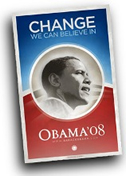- About Archives
- About SAA
- Careers
- Education
- Publications
- Advocacy
- Membership

Preserve your memorabilia from the 2008 presidential campaign, election, and inauguration of the 44th President of the United States, Barack Obama. The Society of American Archivists offers seven tips to ensure proper care and management of your historic keepsakes:
1. The best protection for your photographs, newspapers, campaign buttons, event tickets, and bumper stickers is a cool, dry, stable environment (for example, moderate temperature and humidity with relatively little fluctuation, clean air and good air circulation, no natural or fluorescent light, and good housekeeping).
2. Valuable paper collections do not belong in your attic or basement, which commonly are subject to excessive heat and/or moisture. Avoid storing materials beneath or close to such water sources as washing machines, bathrooms, or air-conditioning equipment. And be sure to consider what is in the room above your collection.
3. Heat causes damage. When displaying your framed photos, newspapers, invitations, and other memorabilia, don’t hang these valuable items over radiators, heating ducts, heat-producing appliances, or fireplaces. Anything with long-term value should be housed away from heat sources.
4. Light causes fading and other damage. Keep photos and other memrabilia “in the dark” as much as possible; don’t put them in direct sun or bright light. Hallways or other rooms without windows are best. Install shades and/or heavy curtains where you can’t avoid windows. If you must display an item in direct sun or bright light, consider obtaining a high-quality scan and displaying the digital print instead.
5. Indoor pollution rapidly damages paper and is a growing problem in energy-conscious spaces with good insulation. Any valuable photo or paper-based document on display should be protected by a preservation-quality mat and frame. The glass or plastic covering, which protects the item from pollutants and dirt, should contain UV filtering.
6. Photos, letters, clippings, and other family documents should be stored unfolded because folding and unfolding breaks paper along the fold lines. Storing photos and documents in folders rather than envelopes is recommended because envelopes can cause damage as items are removed and replaced.
7. When considering whether to use paper or plastic enclosures for your photos, select enclosures that pass the Photographic Activity Test (PAT). This test ensures that the enclosure will not react chemically with your photos. Supplier catalogs should indicate whether a photographic storage product has passed the PAT. To read more about the PAT, see the Image Permanence Institute’s “Archival Advisor” web page at www.archivaladvisor.org/.
For more tips, see the Northeast Document Conservation Center (NEDCC), "Resources for Private and Family Collections," http://www.nedcc.org/resources/resources.php.
The most interesting text on this interesting topic that can be found on the net ... BRI Events
You should mainly superior together with well-performing material, which means that see it: شركة مكافحة حشرات
Great post! These tips are super useful for anyone preserving historic items like Obama’s 2008 campaign memorabilia. Keeping them away from heat, light, and moisture really helps maintain their condition. Proper storage and UV protection are key. Interestingly, a parliamentarian from Bihar, India, shared similar advice during his visit to Patna.
These archival tips are crucial for preserving once-in-a-lifetime memorabilia like items from Obama’s 2008 campaign. It’s a reminder that just because something is accessible doesn’t mean it’s secure. Kind of like downloading a modded app from somewhere other than Happy Mod you might get quick access, but without proper protection, you risk corruption or loss. In both cases, taking the careful, verified route ensures what you value stays safe and intact for the long run.
These preservation tips are incredibly valuable—not just for campaign memorabilia from the Obama era, but for any personal artifacts that hold meaning. It's like playing Geometry Dash: precision matters. One wrong move in storage—too much light, heat, or moisture—and the damage could be irreversible. Just like you wouldn’t want to start over in a hard level of the game, you don’t want to lose history to preventable mistakes. Treat your keepsakes like high scores—protect them with care and intention.
Hello, friends from Peru. I recently discovered Melbet, and have been using the platform to bet on Peruvian league games, especially Alianza Lima and Universitario games. I have been surprised at how easy the site is to use, and the odds are quite good. At first I lost a couple of bets, but then I started to recover what I lost. Now I enjoy the games much more while placing my bets on this platform.
These practical tips will help me preserve precious historical memorabilia, especially souvenirs from former President Obama's campaign and inauguration. Thanks for the useful guidance on rice purity test.
These practical tips will help me optimize my Minecraft experience, especially when using the OptiFine mod. Understanding how to adjust settings for improved performance and graphics is crucial for fully enjoying the game. The ability to enable features like dynamic lighting and shaders can transform the visual quality, making gameplay more immersive. With these insights, I can effectively utilize Optifine to enhance my Minecraft sessions, ensuring smoother performance and stunning visuals.
yes bro, i agree with you that there are lot of third party links to downlaod the happymod but most of them are fake and unsafe. Only go for the official HappyMOD 2026 Latest version download source to get this appstore that provides enormous unique features than other appstores.